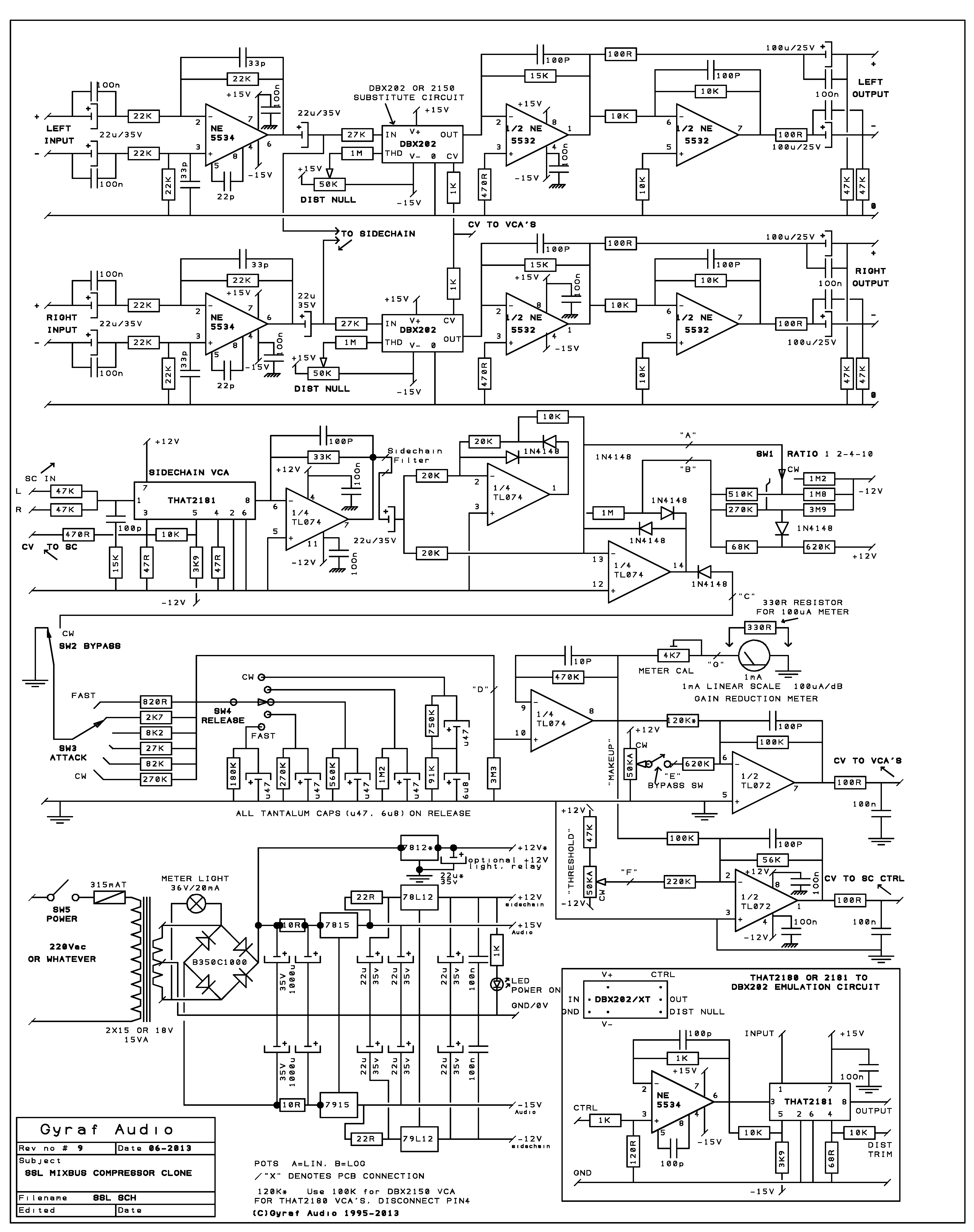

SSThe compressor is cloned from our good old SSL4044E desk, dating back from '85. The SSL mixbus compressor is an integral part of the mixer's main quad fader and autofade system - cards 82E26 and 82E27, and as you can see if you compare these to my schematic, a series of changes have been made for rehousing the circuit. The main changes concerns the electronically balanced input and output and the removal of unneded components regarding the autofade and main fader circuits. Another change is that the sidechain is common to both VCA's, making better tracking abilities - your mix wont' "tilt" so easy when you're compressing heavily. We did things like that to the SSL in the old days. This might seem like a big change, but actually the sonics are preserved very close to the original, and tracking errors are cancelled.
This is a design I did way back in my early years, so you'll have to bear with the ugly pcb layouts. And sorry, this design is absolutely free from tubes and transformers. But it has a nice moving coil meter at least.

My reason for doing this clone is that the SSL is one of the worlds widely recognized stereo mix compressors - it has a well known sound, and is lusted after by many recording engenieers. But the SSL4000 desk is prized as to be out of reach for most small studio owners. This design is - as you'll see - quite simple, easy and economically reachable, so I thought it would make a fine DIY-project for people that know their soldering iron and wants to start building pro quality DIY audio equipment. The beauty of this design is that - contrary to a lot of other esoteric projects - the components are (relatively) easy available anywhere, and no special knowledge, tools or adjustments are needed.
THE COMPONENTS:
The DBX 202XT VCA can be very hard to get these days, so I designed a substitution circuit based on the THAT2180/2181 type VCA - a recent version of the DBX2150 that SSL also uses for their channel compressors. This substitute circuit is based on reverse-engeineering a 202XT VCA - it turned out to consist of ten paralleled 2150's with a common low-impedance buffer for the control inputs. So this is the substitute, but done with only one THAT2180 (or 2181).
I've built the compressor with both the 202, 2150 and 2181, and the "sound" dosent seem to be that different, only the 202 may tend to be a little more transparant than the 2150 - but that's not always a good thing in compressors. Btw, DBX chip production is long gone now, but "Thats" are more than decent substitutes. The "That 2180" is a pre-trimmed replacement for the 2150, the 2181 has external trim. If using the pre-trimmed THAT2180 VCA's, simply cut off (or bend to the side) pin4, which is the distortion trim connection. The THAT VCA's are available - not everywhere, but still - from several web-based sources nowadays - my favorite supplier is ProFusion in the UK - they will sell small amounts, and will ship to all over the world
As this compressor was originally designed for using the - now obsolete - DBX2150 VCA's, there is a change in one resistor that is necessary to obtain the correct ratios - look here to see the component in question - the 100K resistor marked has to be replaced by a 127K resistor to compensate for higher input current sensitivity on the new chips.
The anatomy of this compressor is surprisingly simple:
Input signals are de-balanced by a couple of NE5534's, who in turn are driving the VCA in current mode via 27K resistors - the THAT VCA's are current in - current out devices (note that on the old component overlay, these resistors are marked 15K look here). From the VCA's the signal is taken to a current-to-voltage converter combined with a simple, yet proven, balanced output drive stage, consisting of two NE5532's. This concludes the story of the audio path. Not much electronics to mess up your precious audio signal here.

The signals from the input opamps are also summed via 47k's and sent to the input of the sidechain VCA. The purpose of this VCA is to act like a tracking "dummy" VCA, paralleling the GR action of the main VCA's, and thereby making it possible (in the original design, the 4000E console) to use the single set of main VCA's for compression, fader, computer and autofader at the same time - without having to resort to less predictable feed-forward compression schemes. So this is a combination of a feed-forward and a feed-back arcitechture, acting mostly as a feed-back compressor

The sidechain signal that is obtained after the VCA is then full-wave rectified by two TL074-stages, and at this point an offset is added - and signal gain is controlled - by the ratio switch. The ratio switch actually changes the threshold a bit to compensate for level flukturations caused by different ratio settings. This is the only part of the design that in any way differs from a direct off-the-application-note design.
The rectified sidechain DC is now fed thru the bypass switch and one of the bank of resistors selected with the "attack time" switch, to charge a tantalum capacitor selected with the "release time" switch. These release tantalums are bypassed with different sized discharge resistors, each delivering the desired release time. The fifth step on the release is an "Auto" setting, combining two release time constants (91k+6u8 and 750k+u47). This will give short time constants for short programme peaks, but if compression is going on for a longer time, the slow time constant will set in. Right after the book.
This rectified - and now timed - DC sidechain signal is buffered, and sent to three different circuits:

First of all it's summed with a DC voltage coming from the "makeup gain" pot, and used to control the main VCA's. On the original SSL compressor the makeup gain pot is active all the time, so when bypassed there's excess gain. On the control PCB I've made an option for disconnecting the makeup gain when bypassed, leaving the makeup gain more useable for in/out comparison. This can be shorted if you prefer the original scheme - but I don't think you will.

The DC sidechain control signal is also summed with another DC voltage - coming from the "threshold" pot - and used to control the sidechain VCA. In this way the added gain in the sidechain VCA looks to the rectifier like there's more signal coming in, changing the threshold this way. The "real" threshold to be overcome before charging the attack/release caps, is the 0.6V AK voltage across the diode placed between the fullwave rectifier and the A/R timing. Note that, for use with modern-day levels, the threshold potentiometer can seem to be too sensitive; in this case, mount a 47K resistor between the control PCB and the +side of the threshold potentiometer - look here for details
The last use of the rectified, timed and and buffered signal is driving the 1mA GR-meter for monitoring of the ongoing compression. This is linear scale, at about 50uA/dB, making a 1mA meter showing 20dB full-scale. If you want to have a meter reading of 0-10dB full scale, replace the 2K resistor (on the main board, right next to the connector to the control board) with a 1K. You can use just about any linear-scale meter you like, just changing the 2K resistor in series with it. For a 100uA meter, the simplest way is to shunt a 330R resistor across the meter. Another option is to mount a trimmer potentiometer right at the meter, and adjust to taste

The power supply part should be pretty much self-explanatory, the only weird part being that it's both +-12V and +-15V. The 12V's are used in the board as subregulators for obtaining predictable gains in case the main (+-15V) supply fluctuates.